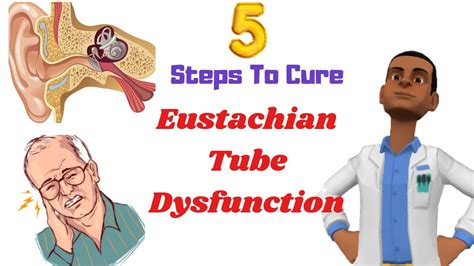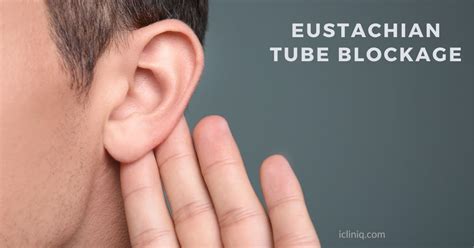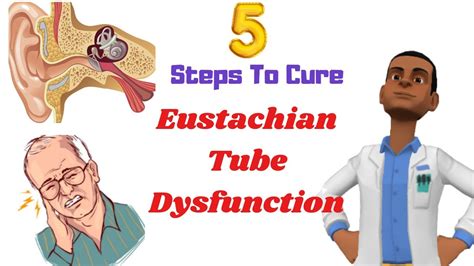Intro
Relieve Eustachian tube blockage with 5 effective methods, including ear popping techniques, nasal sprays, and home remedies to restore ear pressure balance and alleviate discomfort, tinnitus, and hearing issues.
The Eustachian tube, also known as the auditory tube, plays a crucial role in maintaining the balance of air pressure in the ears. When the Eustachian tube becomes blocked or clogged, it can lead to discomfort, hearing loss, and even ear infections. Many people experience Eustachian tube dysfunction at some point in their lives, often due to colds, allergies, or sinus infections. Fortunately, there are several ways to clear the Eustachian tube and alleviate symptoms. In this article, we will explore the importance of Eustachian tube function, the causes of blockage, and provide guidance on how to clear the Eustachian tube.
The Eustachian tube connects the middle ear to the back of the throat and nose. Its primary function is to regulate air pressure in the ears, allowing us to hear properly and maintain balance. When the Eustachian tube becomes blocked, it can cause a range of symptoms, including ear fullness, hearing loss, and ear pain. In severe cases, a blocked Eustachian tube can lead to more serious complications, such as middle ear infections or eardrum damage. Understanding the causes of Eustachian tube blockage is essential to finding effective solutions.
Eustachian tube blockage can be caused by a variety of factors, including colds, allergies, sinus infections, and anatomical abnormalities. When the nasal passages or sinuses become congested, it can lead to swelling and blockage of the Eustachian tube. In some cases, a blocked Eustachian tube can be a symptom of an underlying condition, such as a deviated septum or nasal polyps. Identifying the underlying cause of Eustachian tube blockage is crucial to developing an effective treatment plan. By understanding the causes and symptoms of Eustachian tube dysfunction, individuals can take steps to prevent and treat blockage, promoting overall ear health and well-being.
Understanding Eustachian Tube Function

Causes of Eustachian Tube Blockage
Eustachian tube blockage can be caused by a variety of factors, including: * Colds and upper respiratory infections * Allergies and sinus infections * Anatomical abnormalities, such as a deviated septum or nasal polyps * Eustachian tube dysfunction, which can be caused by a variety of factors, including genetics and environmental factors By understanding the causes of Eustachian tube blockage, individuals can take steps to prevent and treat blockage, promoting overall ear health and well-being.5 Ways to Clear Eustachian Tube

Additional Tips for Clearing Eustachian Tube
In addition to these methods, there are several other tips that can help to clear the Eustachian tube, including: * Avoiding allergens and irritants, such as tobacco smoke and strong chemicals * Using a humidifier to add moisture to the air and promote drainage * Elevating the head while sleeping to reduce congestion and promote drainage * Avoiding flying or traveling to high altitudes, which can exacerbate Eustachian tube blockagePreventing Eustachian Tube Blockage

When to Seek Medical Attention
In some cases, Eustachian tube blockage can be a symptom of an underlying condition that requires medical attention. If symptoms persist or worsen over time, it is essential to seek medical attention. Some signs that may indicate the need for medical attention include: * Severe ear pain or discomfort * Fever or chills * Discharge or bleeding from the ear * Hearing loss or difficulty hearing * Dizziness or vertigoTreatment Options for Eustachian Tube Blockage

Surgical Options for Eustachian Tube Blockage
Surgical options for Eustachian tube blockage may be necessary in cases where symptoms are severe or persistent. Some surgical options include: * Myringotomy: a procedure that involves making a small incision in the eardrum to relieve pressure and promote drainage * Tympanostomy tubes: small tubes that are inserted into the eardrum to promote drainage and relieve pressure * Eustachian tube dilation: a procedure that involves using a balloon or other device to dilate the Eustachian tube and promote drainageConclusion and Final Thoughts

We invite you to share your thoughts and experiences with Eustachian tube blockage in the comments section below. Have you tried any of the methods mentioned in this article? What worked best for you? By sharing your story, you can help others who may be experiencing similar symptoms and promote a greater understanding of this common condition.
What is the Eustachian tube and what is its function?
+The Eustachian tube, also known as the auditory tube, connects the middle ear to the back of the throat and nose. Its primary function is to regulate air pressure in the ears, allowing us to hear properly and maintain balance.
What are the symptoms of Eustachian tube blockage?
+Symptoms of Eustachian tube blockage can include ear fullness, hearing loss, ear pain, and discomfort. In severe cases, a blocked Eustachian tube can lead to more serious complications, such as middle ear infections or eardrum damage.
How can I clear my Eustachian tube?
+There are several ways to clear the Eustachian tube, including the Valsalva maneuver, Toynbee maneuver, nasal decongestants, steam inhalation, and Eustachian tube exercises. It is essential to consult with a healthcare professional to determine the best course of treatment for Eustachian tube blockage.
When should I seek medical attention for Eustachian tube blockage?
+If symptoms persist or worsen over time, it is essential to seek medical attention. Some signs that may indicate the need for medical attention include severe ear pain or discomfort, fever or chills, discharge or bleeding from the ear, hearing loss or difficulty hearing, and dizziness or vertigo.
Can Eustachian tube blockage be prevented?
+Yes, Eustachian tube blockage can be prevented by practicing good hygiene, avoiding allergens and irritants, using a humidifier to add moisture to the air, and elevating the head while sleeping to reduce congestion and promote drainage.
